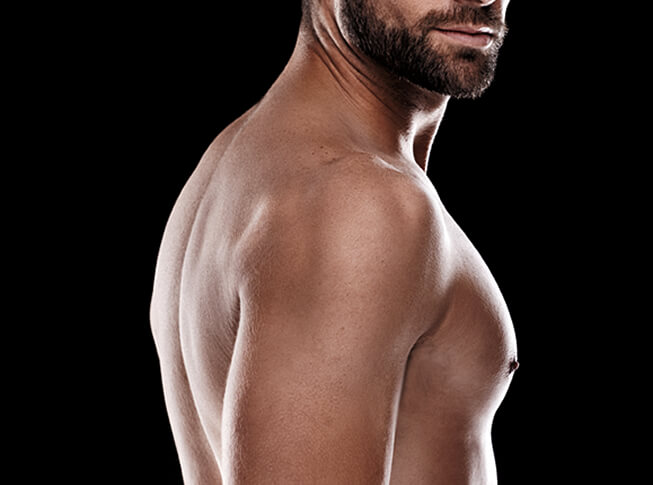

101 OLD SHORT HILLS RD, WEST ORANGE, NJ 07052
973.731.7000
620 PARK AVENUE, NEW YORK, NY 10065
212.938.0158
Gynecomastia NJ
Male Breast Reduction
Male breast reduction can help remove excess fat and tissue to create a more masculine-looking chest. Men with larger breasts may be embarrassed of their body and uncomfortable wearing any form-fitting clothing. Some men with enlarged breasts also have difficulty enjoying sports or physical activities. Afraid to take their shirt off in public, many men decline to partake in social activities that will make them uncomfortable, affecting their quality of life. At Asaadi Plastic Surgery, we can help you achieve a more sculpted chest with gynecomastia surgery.
What Is Gynecomastia?
Gynecomastia is the medical term that is given to men with enlarged breasts. While gynecomastia is often not talked about, it is a common condition that affects a large amount of men. Gynecomastia can affect one breast or both breasts. Men may experience gynecomastia for a variety of reasons, including obesity, genetics, side effects of medication or medical condition, and even hormonal imbalances. In some cases, gynecomastia can be improved by adjusting medications, prescribing new medications, or lifestyle alterations, but when these changes do not improve gynecomastia, male breast reduction surgery can help.
Gynecomastia surgery removes excess tissue and fat that causes enlarged breasts. Gynecomastia can even remove excess skin in cases of extreme weight loss. The chest will appear firmer, flatter, and more masculine after excess skin is removed. Male breast reduction surgery can help treat enlarged breasts that are resistant to proper diet and exercise. The process of treating gynecomastia varies depending on what causes your particular case of gynecomastia. During male breast reduction surgery, there are 2 main differences in treatment, which include treating excess glandular tissue and excess fatty tissue.
Excess glandular tissue will be surgically excised from the breast for a more contoured appearance. Glandular tissue removal may also be combined with liposuction to achieve an even firmer chest. Any liposuction incisions are discreetly placed so that there is little to no visible scarring after your gynecomastia surgery. In most cases, a liposuction incision is placed around the areola or underarm. Excess glandular tissue will be surgically removed from the bottom of the breast and around the areola.
Liposuction is routinely performed in cases of removing excess fatty tissue during gynecomastia surgery. Liposuction incisions are inconspicuously placed along the areola or the underarm to provide the most natural-looking gynecomastia results. A cannula (slim tube) will be gently inserted through these incisions to remove the excess fat from your breast, contouring the chest to be more firm, flat, and sculpted. In some cases of gynecomastia, the nipples and areolas may need to be placed higher for a more natural-looking chest. The nipples and areolas may also be reshaped during gynecomastia surgery to better fit the shape and size of your chest after male breast reduction surgery.
| Removing Excess Glandular Tissue | Removing Excess Fatty Tissue |
|---|---|
| Glandular tissue will be surgically excised | Fatty tissue will be removed through liposuction |
| May also be combined with liposuction | Liposuction will be performed through small incisions on the areolas or underarms |
| Excess glandular tissue removed from bottom of the breast and around areola | Excess fatty tissue will be removed in layers to define your chest |
What Can I Expect Before My Gynecomastia Surgery?
Your gynecomastia consultation will consist of an evaluation of your general health, medical history, and a breast evaluation to determine the extent of breast reduction needed. Dr. Asaadi may run some medical tests to further understand your case of gynecomastia and to determine its cause. If Dr. Asaadi finds an underlying cause for your case of gynecomastia, he may refer you to a leading specialist or doctor who can help you treat gynecomastia without surgery. On the other hand, if there is no underlying medical cause, Dr. Asaadi can begin to personalize your male breast reduction surgery to best meet your particular needs. Ideal gynecomastia candidates are looking to reduce the size of their breast and create a more sculpted, contoured chest.
After assessing the amount of excess glandular tissue or fatty tissue present, Dr. Asaadi can determine which gynecomastia surgical technique will be best for your particular case. Some medications may need to be stopped prior to your gynecomastia surgery, especially any medications that may thin your blood. On the day of your male breast reduction surgery, we advise that you wear comfortable, loose-fitting clothing with no jewelry.
What Can I Expect After My Gynecomastia Surgery?
Common gynecomastia side effects include slight discomfort, swelling, or bruising. Side effects vary depending on what technique is performed during your gynecomastia surgery. Any discomfort can be minimized through an oral medication prescribed by Dr. Asaadi. It is important that you have someone accompany you to your gynecomastia surgery, as you will not be able to drive immediately following your male breast reduction procedure. If possible, you should have a friend or family member stay with you the first 1-2 days following your gynecomastia surgery.
A drain may be placed during your gynecomastia surgery to remove any excess fluid or liquid from your surgical site. Your chest will be bandaged to keep your healing skin firmly in place and to avoid any potential irritation to your incisions. To promote proper healing, you may be prescribed a compression garment to reduce the severity of swelling for the first 1-2 weeks following your male breast reduction surgery. Swelling and bruising will continue to lessen in the weeks following your gynecomastia surgery. While you may notice initial improvements in your chest, final gynecomastia results will appear in the weeks and months following your male breast reduction surgery, as your swelling continues to fade.
After your gynecomastia surgery, light walking may help you begin to return to your normal activity. While each patient heals at a different rate, many patients feel well enough to return to work 2-3 days following male breast reduction. Stitches are generally removed 1-2 weeks after your gynecomastia surgery, depending on your rate of healing. You will not be able to partake in strenuous activity or sports for at least 4 weeks following your male breast reduction to reduce the chance of any stress or injury occurring to your healing chest. We also suggest you do not expose your incisions to direct sunlight for 6 months to reduce the possibility of visible scarring.
The Importance Of Choosing A Highly Experienced Gynecomastia Surgeon
It is important that you choose a skilled gynecomastia surgeon who understands your individual anatomy, as every patient’s body is different. When the right plastic surgeon performs male breast reduction, there is usually no need for a revision. Dr. Asaadi stresses the importance of choosing a qualified, experienced, and board-certified plastic surgeon when considering gynecomastia.
How Do I Get Started With Gynecomastia Surgery?
Dr. Mokhtar Asaadi and our staff will be happy to discuss gynecomastia with you. Please contact our New Jersey office at 973.731.7000 or our New York office at 212.938.0158 to schedule a private consultation. You may also request an appointment online to meet with our gynecomastia surgeon.


